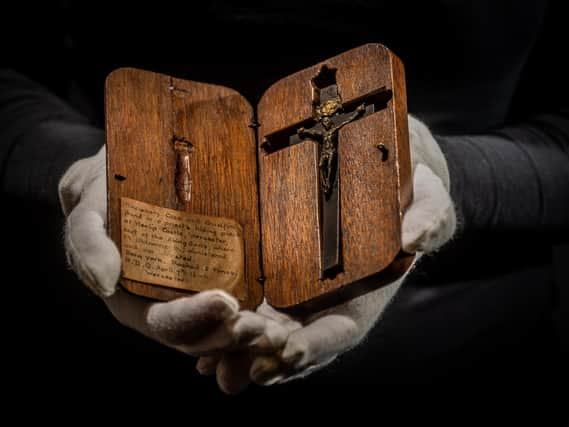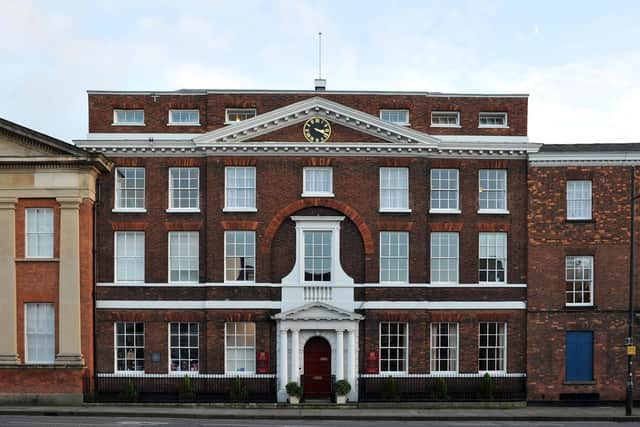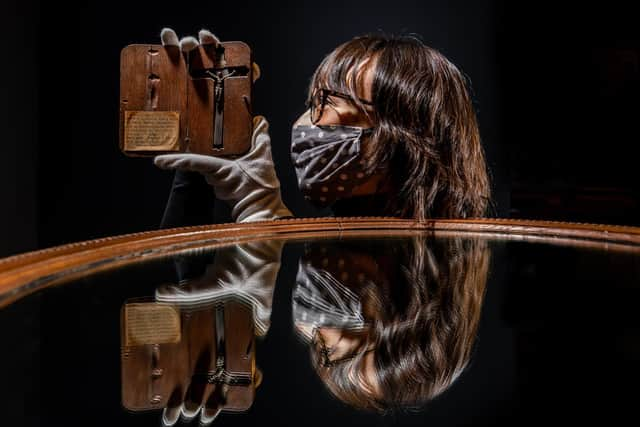Crucifix belonging to Catholic priest hung, drawn and quartered over Gunpowder Plot in 1606 on display in York


But the failed Gunpowder Plot of 1605 had disastrous consequences for those involved and even those who had nothing to do with the plot but came under suspicion faced savage punishment – including priests such as Father Edward Oldcorne.
A crucifix on display at England’s oldest living convent, the Bar Convent in York, tells the chilling story of what happened to Father Oldcorne. The label states that Oldcorne was “Born York. Racked 5 times. H.D.Q. April 7th 1606. Worcester.”
Advertisement
Hide AdAdvertisement
Hide AdH.D.Q refers to his terrible fate - being hung by the neck till nearly dead, drawn, or disembowelled while still alive and then cut into four quarters - despite there being no evidence to link him to the Gunpowder Plot.


Fr Oldcorne went to St Peter’s School in York and was friends with the Gunpowder Plotters York-born Guy Fawkes and brothers Christopher and John Wright, from Welwick, in Holderness.
When the plot, designed to blow up the House of Lords and kill King James I to enable a Roman Catholic monarch to take the throne, was revealed, Oldcorne, who was under suspicion as a Catholic priest and Jesuit, went into hiding with three others in two priest holes at Hindlip Hall, Worcester.
Although the house was raided several times, they were never discovered.
Advertisement
Hide AdAdvertisement
Hide AdHowever, conditions in the priest’s hole became unbearable and, after eight days, they surrendered.


The crucifix was found in the priest’s hole where Fr Oldcorne had been hiding and is thought to be the only object from the hiding place to have survived.
Fr Oldcorne was subjected to terrible torture on the rack and then - despite the lack of evidence - put to death on April 7 1606, with his servant Ralph Ashley executed alongside him.
A third man, Nicholas Owen, who had spent 18 years building priest holes in the homes of Catholic families, died while being tortured during the night of 1/2 March 1606. It is said his work was so ingenious that many of his hiding places have yet to be discovered.
Advertisement
Hide AdAdvertisement
Hide AdA fourth man, Father Henry Garnet, a Jesuit priest, had been told about the plot months before in confession, but was forbidden by canon law to reveal it. He was hung, drawn and quartered on May 3 1606.
Sister Patricia Harriss said Fr Oldcorne “wasn’t in on the plot, or knew about it beforehand” but as a priest was “totally suspect”.
When the two priests emerged from their hiding place, they came out “apparently looking like ghosts - even the people arresting them were terribly shaken.”
The crucifix would have offered Fr Oldcorne - who was beatified in 1929 - comfort in his final days, Sister Harriss said.
Advertisement
Hide AdAdvertisement
Hide AdShe added: “It was such a terrible tragedy for the whole of the Catholic community - they were very closely connected.
“There was a lot of nobility who had intermarried - everybody knew everybody.
“It caused such grief.”
The Bar Convent was established by Mary Ward, niece of the Wright brothers and another plotter Thomas Percy.
Priest holes in Yorkshire
Catholics built hideaways for the clergy in their homes.
The priest hole at Ripley Castle, discovered in 1963, was large enough for a man to crouch down, with just enough room for a candle and a Bible.
Advertisement
Hide AdAdvertisement
Hide AdFear of persecution lingered into the 18th century and the priest hole in the chapel at the Bar Convent, which dates back to 1729, is thought to have been one of the last built.
With room for at least three people it was a “mansion” compared to Ripley but it is not known whether it was used..
Comment Guidelines
National World encourages reader discussion on our stories. User feedback, insights and back-and-forth exchanges add a rich layer of context to reporting. Please review our Community Guidelines before commenting.